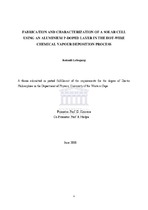| dc.contributor.advisor | Knoesen, Dirk | |
| dc.contributor.advisor | Madjoe, Reginaldt | |
| dc.contributor.author | Lebogang, Kotsedi | |
| dc.date.accessioned | 2014-07-02T11:41:24Z | |
| dc.date.available | 2014-07-02T11:41:24Z | |
| dc.date.issued | 2010 | |
| dc.identifier.uri | http://hdl.handle.net/11394/3441 | |
| dc.description | Philosophiae Doctor - PhD | en_US |
| dc.description.abstract | When the amorphous silicon (a-Si) dangling bonds are bonded to hydrogen the concentration of the dangling bond is decreased. The resulting film is called hydrogenated amorphous silicon (a-Si:H). The reduction in the dangling bonds concentration improves the optoelectrical properties of the film. The improved properties of a-Si:H makes it possible to manufacture electronic devices including a solar cell.A solar cell device based on the hydrogenated amorphous silicon (a-Si:H) was fabricated using the Hot-Wire Chemical Vapour Deposition (HWCVD). When an n-i-p solar cell configuration is grown, the norm is that the p-doped layer is deposited from a mixture of silane (SiH4) gas with diborane (B2H6). The boron atoms from diborane bonds to the silicon atoms and because of the number of the valance electrons, the grown film becomes a p-type film. Aluminium is a group 3B element and has the same valence electrons as boron, hence it will also produce a p-type film when it bonds with silicon.In this study the p-doped layer is grown from the co-deposition of a-Si:H from SiH4 with aluminium evaporation resulting in a crystallized, p-doped thin film. When this thin film is used in the n-i-p cell configuration, the device shows photo-voltaic activity.The intrinsic layer and the n-type layers for the solar cell were grown from SiH4 gas and Phosphine (PH3) gas diluted in SiH4 respectively. The individual layers of the solar cell device were characterized for both their optical and electrical properties. This was done using
a variety of experimental techniques. The analyzed results from the characterization techniques showed the films to be of device quality standard. The analysed results of the ptype layer grown from aluminium showed the film to be successfully crystallized and doped.A fully functional solar cell was fabricated from these layers and the cell showed photovoltaic activity. | en_US |
| dc.language.iso | en | en_US |
| dc.subject | Hot-Wire chemical vapour deposition | en_US |
| dc.subject | Aluminium | en_US |
| dc.subject | Doping | en_US |
| dc.subject | Hydrogenated amorphous silicon | en_US |
| dc.subject | Phosphine | en_US |
| dc.subject | Solar cell | en_US |
| dc.subject | Photovoltaic | en_US |
| dc.subject | Nanocrystalline | en_US |
| dc.subject | Thin film | en_US |
| dc.subject | Indium tin oxide | en_US |
| dc.title | Fabrication and characterization of a solar cell using an aluminium p-doped layer in the hot-wire chemical vapour deposition process | en_US |
| dc.type | Thesis | en_US |

